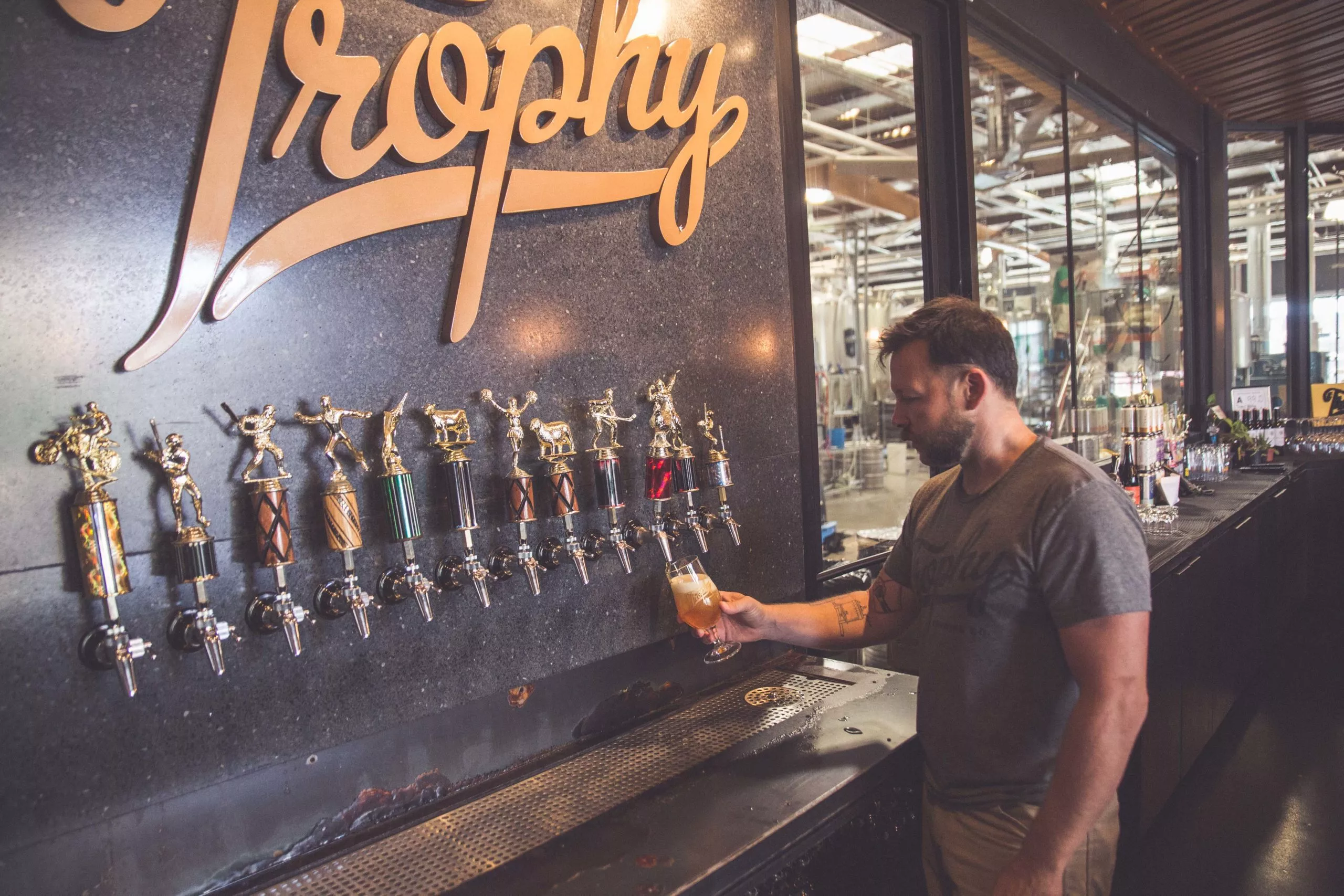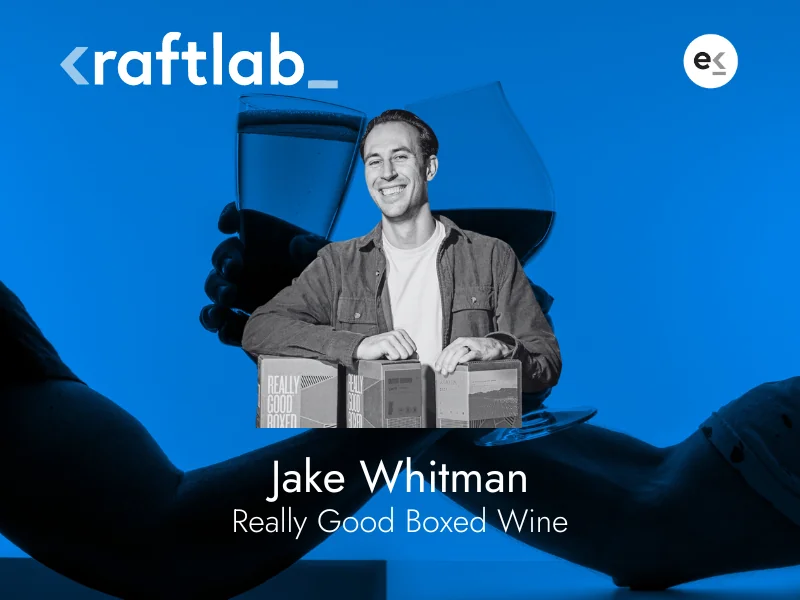Whether you’re a seasoned brewer or just opening your taproom doors, success comes from more than what’s in the glass. It’s about creating those can’t-miss moments that turn first-time visitors into regulars and casual sippers into passionate advocates. And while Vermont may be leading the pack with nearly 15 breweries per capita, craft breweries everywhere are cooking up creative ways to stand out and connect with their communities.
The good news? In today’s digital age, where brewery software streamlines operations and consumers crave authentic experiences, smart marketing strategies can help you build a brand that resonates with customers and keeps them coming back for more. Let’s dive into the basics of brewery marketing and 10 proven strategies that will help you build a brewery brand as distinctive as your signature IPA.
As a companion to this post, we created a downloadable marketing plan template so you have a centralized spot to establish your goals and set a precedent for your marketing strategy to reference as your business grows. Now, sit down, pen in hand, and get to work on this strategy for your brewery.
The Art of Building Your Brewery Marketing Brand: More Than Just a Logo
Your brewery’s brand is the story you tell without saying a word. It’s in the warmth of your taproom lighting, the personality of your can designs, and even the tone of your Instagram captions. Start by defining your unique position in the market—are you the innovative experimenters, the traditional craftsmen, or perhaps the community gathering spot? This positioning should influence everything from your visual identity to your messaging.
Next, consider your target audience to develop your brand voice. Are you speaking to young urban professionals who appreciate clever wordplay and craft beer culture? Or are you targeting families and outdoor enthusiasts who value authenticity and community? Your brand voice should feel natural and consistent across all platforms, whether it’s your menu descriptions, social media posts, or email newsletters.
Consider your mission. Was there something special that inspired you to start your brewery? Use that in your messaging. Slackwater Brewing in British Columbia, Canada, says it is all about making beer for people who love nature. This is obvious by looking at their offerings, the content they post, and what they talk about. Posts like the one above can seem inconsequential, but they actually serve an important purpose: branding.
Slackwater’s press helps them out too. This story says that Slackwater is hosting a fly fishing film festival at their brewery. The couple who owns Slackwater went on and on in the story about their love for fly fishing and how the business was founded “‘mid-cast and hip-deep in a mountain stream,’” according to the owners.
As we’ve established, how you speak about your business matters. Clearly the Slackwater brewing family has learned this, and it’s working to their advantage. By promoting their story and interests, they’re demonstrating that their brewery is a space for adventure-seekers who enjoy beer and a laid-back environment.
The visual elements of your brand—from your logo to your tap handles—should tell a cohesive story. Take inspiration from breweries like Anchorage Brewing Company, which collaborates with local artists to create distinctive can designs that reflect their Alaskan heritage and commitment to unique brewing. The artwork is part of Anchorage’s mission to take “extreme steps to produce some of the most unique beers ever made” according to their website.
Remember, in a crowded craft beer market, memorable branding isn’t just about standing out—it’s about standing for something.
Get Your Marketing Gameplan Going: Start with Strategy
Before you start posting on Instagram or designing merch, you need a solid foundation. Recent Forbes research shows that 94% of global consumers value companies with a strong purpose beyond just selling products.
Your purpose—whether it’s bringing people together through shared experiences, preserving traditional brewing methods, or championing local agriculture—will directly shape your market position and help you stand out from competitors. Understanding both your purpose and your current market standing creates the framework for all your marketing decisions.
First, conduct a simple SWOT analysis (Strengths, Weaknesses, Opportunities, Threats) focusing on key areas like:
- Location and physical space. Consider factors like foot traffic, parking, capacity for events, and whether your industrial location could be a destination spot.
- Product lineup and quality. Evaluate your flagship beers, seasonal offerings, and any gaps in your portfolio compared to local competition.
- Staff expertise and size. Assess your team’s strengths, including brewing expertise, customer service skills, and potential marketing talent.
- Distribution channels. Map out your current reach through taproom sales, distribution partnerships, and retail presence.
- Local competition. Analyze other breweries’ offerings, pricing, and market position to find your unique angle.
- Community partnerships. Identify existing relationships with local businesses, events, and organizations, plus opportunities for growth.
Set concrete, measurable goals for your marketing efforts. Maybe you want to increase taproom visits by 25% this year, or boost your direct-to-consumer sales by $100,000. Whatever your objectives, make them specific and trackable. Consider both short-term wins (like increasing weekend taproom traffic) and long-term growth (like expanding distribution or building brand recognition).
Related: Free Webinar: Master Your Craft Beverage Distribution Channels
Effective beer marketing strategies align with your broader business mission and core values. Are you aiming to become the go-to local hangout? Looking to expand distribution across the state? Want to be known for innovative seasonal releases?
Let these big-picture goals guide your marketing decisions. Successful brewery marketing isn’t about following trends—it’s about creating a sustainable plan that aligns with your business objectives and resonates with the customers you’ve identified in your brand development.
Finally, set a realistic marketing budget. Industry experts recommend that newer breweries (under 5 years) allocate 12-20% of gross revenue to marketing, while established breweries typically spend 8-12%. Prioritize activities that offer the highest return on investment with the lowest barrier to entry.
Related: Maximize Your Brewing Potential With Ekos Brewery Management Software
10 Winning Brewery Marketing Strategies That Work
Marketing your brewery isn’t just another task—it’s your chance to tell your unique story and invite people into your world. These 10 strategies are your roadmap to creating a brewery brand that doesn’t just sell beer, but builds a community.
Whether you’re a small startup searching for craft beer marketing ideas or an established taproom looking to expand, these tactics will help you connect with beer enthusiasts, create memorable experiences, and turn casual sippers into die-hard fans.
1: Build a Strong Online Social Presence
Let’s face it—your website and social channels are probably the first place people will discover your brewery. Make that first impression count! When developing your beer marketing strategy, start with a mobile-friendly website that shows off your current tap list, hours, and events. Keep those social feeds fresh with behind-the-scenes brewing action, new release announcements, and shots of your awesome taproom vibe.
Here’s the thing about digital presence—it’s more than just the basics. Your website should tell your story through killer visuals and easy navigation. Think online merch stores, event signups, and brewing insights that keep people clicking. Meanwhile, your social channels can build buzz for new releases and showcase the personalities behind your brand.
In Action: A craft beer enthusiast discovers your brewery through Instagram, where you’ve posted a time-lapse video of your latest small-batch brew day. They click through to your website, where they can easily browse your current tap list, sign up for an upcoming tasting event, and even purchase a gift card for a friend. That’s an effective digital presence at work.
2: Develop a Customer Loyalty Program
Think about it—keeping regulars is way cheaper than chasing new customers. In fact, stats show that retaining customers costs five time less than acquiring new ones. Create a membership program that gets people excited about coming back, with perks like first dibs on special releases, exclusive events, or points toward free swag. The best part? You’ll learn exactly what your biggest fans love.
Here’s where it gets exciting: Use those member insights to shape everything from your email campaigns to your next seasonal release. Watch which beers and events get people talking, then do more of what works. Smart, right?
In Action: A customer joins your loyalty program during their first taproom visit. They receive a welcome email with a point bonus and details about an upcoming members-only release party. After attending the event, they share their exclusive experience on social media, bringing their friends to the next one. Within months, they’re among your top brand advocates.
3: Master Local SEO and Business Presence
Ready to get found? When beer lovers search for their next great taproom experience, you want to be right at the top of those results. Keep your Google Business Profile fresh with current hours, mouth-watering photos, and friendly responses to reviews.
The cool part? Local SEO goes way beyond Google. Team up with food bloggers and lifestyle sites in your area. Get your customers excited about sharing photos and tagging your location on social media, building a visual portfolio of authentic experiences that attract new visitors. Before you know it, you’ll have a whole digital army spreading the word.
In Action: A group of friends planning a weekend brewery tour finds your taproom through a Google search. Your high rating, recent photos, and upcoming events calendar convince them to make your brewery their first stop. They arrive knowing exactly what to expect and end up staying twice as long as planned.
4: Create an Immersive Taproom Experience
Time to level up your taproom game! Transform your space into more than just a place to grab a beer. Run engaging brewery tours, design Instagram-worthy tasting flights, and create those “you had to be there” moments that keep people coming back.
Here’s what makes it magic: Every detail counts. From the playlist setting the mood to the story behind each brew, make every visit memorable. Train your team to be storytellers—the best conversations happen over great beer.
In Action: A couple visits your taproom for a Saturday afternoon tour. They’re greeted by a knowledgeable guide who walks them through the brewing process, sharing stories about your signature recipes. After the tour, they enjoy a carefully curated tasting flight, complete with tasting notes and food pairing suggestions. They leave with photos, merchandise, and plans to bring back their beer-loving friends.
Related: Free Guide: Ekos’ Taproom Toolkit, Best Practices for Profitability
Strategy #5: Supercharge Your Merchandise Strategy
Let’s talk merch! Quality merchandise turns your happy customers into walking billboards for your brand. Think beyond the basic logo tee—create apparel and accessories people actually get excited about wearing, from butter-soft hoodies to sleek growlers that make a statement.
Got a creative community? Tap into it! Partner with local artists for unique designs that capture your brand’s personality. And hey, don’t forget about sustainability—your eco-conscious customers will appreciate thoughtful choices in materials and production. Keep tabs on what flies off the shelves and what doesn’t to keep your merch game strong.
In Action: Your limited-edition winter release includes artist-designed hoodies featuring your seasonal stout label art. The merch drops simultaneously with the beer release, creating buzz across both product lines and driving cross-category purchases.
Strategy #6: Leverage Email Marketing Effectively
Here’s a secret weapon: email marketing packs a serious punch in the ROI department. Build your list organically through taproom visits and events—these are folks who already dig what you’re brewing. Then, get smart about sending them content they’ll actually want to open.
Make those emails pop with eye-catching visuals, and keep mobile users in mind (because who isn’t checking email on their phone these days?). Mix it up with brewing stories, food pairings, and behind-the-scenes peeks. Automate the basics like welcome emails and birthday treats, but keep that personal touch that makes craft beer special.
In Action: A subscriber receives your monthly newsletter featuring stunning photos of your new seasonal release, alongside an interview with your head brewer about the inspiration behind the recipe. They click through to reserve tickets for the release party.
Strategy #7: Host Strategic Events
Ready to turn your taproom into the place to be? When brainstorming brewery marketing ideas and beer promotion ideas, think beyond basic tastings—how about trivia nights that get competitive juices flowing, or food truck festivals that make your spot the weekend destination? The key is creating events that feel authentically “you” while drawing different crowds through your doors.
Keep track of what works—attendance numbers tell a story, but so do those Instagram tags and Facebook shares. Team up with local businesses and charities to spread the love (and your reach). The goal? Create those can’t-miss events that have people marking their calendars months in advance.
In Action: Your monthly “Brews & Blues” night pairs limited-release experimental beers with local blues musicians. The event consistently sells out, generates social media buzz, and has become a staple of the local music scene.
Strategy #8: Build Powerful Local Partnerships
Next up is teamwork! Partner with local restaurants, food trucks, artists, and other businesses to create something bigger than beer. Cross-promote with complementary businesses, sponsor community events, and become part of your area’s fabric.
The magic happens when partnerships feel natural and both sides win. Maybe your porter becomes the secret ingredient in a local chef’s chocolate cake, or your taproom hosts monthly artisan markets. Get creative with collaborations that make sense for your brand.
In Action: You team up with a popular local coffee roaster for a special coffee stout release. They feature your beer at their cafes, you serve their coffee in your taproom, and both audiences discover something new.
Strategy #9: Get Your PR Game Right
Time to spread the word! Build relationships with local media, beer bloggers, and influencers who can share your story. The key? Make it newsworthy. New releases, innovative brewing techniques, community initiatives—these are stories waiting to be told.
Don’t just wait for coverage—create it. Write compelling press releases, share your expertise on industry topics, and be available when reporters need a quick quote about craft beer trends. Better yet, invite them to experience your brewery firsthand.
In Action: A local food writer visits your brewery for a story about sustainable brewing practices. Your commitment to local ingredients and water conservation becomes a feature article, positioning you as an industry leader.
Strategy #10: Harness the Power of Data
Here’s where brewery marketing gets smart. Use your sales data, website analytics, and social media insights to make informed decisions. Which beers are flying off the shelves? What events pack the house? When do people engage most with your content?
Track everything that matters—but don’t get lost in the numbers. Focus on metrics that help you serve your customers better and grow your business. Use these insights to refine your marketing strategy and invest in what works.
In Action: Your sales data shows that food truck events consistently drive 40% higher taproom sales and increase distribution orders. Using these insights, you expand your food truck program and adjust your marketing calendar accordingly. The result? A successful monthly “Street Food & Suds” festival that’s become your highest-performing regular event.
Tracking Your Marketing Success: Metrics That Matter
Measuring the impact of your marketing efforts helps you optimize spending, improve customer engagement, and maximize ROI across all channels. Track these key metrics to ensure your strategies are delivering results:
- Digital Engagement: Track website visits, social media interactions, and email open rates to gauge content effectiveness
- Event Performance: Measure attendance, revenue per event, and repeat attendance rates
- Loyalty Program Metrics: Monitor membership growth, redemption rates, and average spend per member
- Sales Impact: Track correlation between marketing initiatives and sales spikes, including distribution performance
- Brand Awareness: Measure social mentions, press coverage, and branded search volume
- Customer Acquisition Cost: Calculate marketing spend versus new customer revenue
- Customer Lifetime Value: Track long-term value of customers acquired through different marketing channels
- ROI by Channel: Compare performance across different marketing initiatives to optimize spending
By consistently monitoring these metrics, you can identify which strategies resonate most with your audience and adjust your marketing mix accordingly. Brewery marketing is an iterative process—use these insights to continuously refine your approach and drive better results over time.
Ready to Take Your Brewery Marketing to the Next Level?
Successful brewery marketing combines creativity with data-driven decisions. Each strategy we’ve covered—from building a strong digital presence to hosting unforgettable events—works best when part of a cohesive plan. Start by implementing the strategies that best align with your goals and resources, then expand as you grow.
The secret to marketing success? Having systems that give you the insights to make smart decisions. Modern brewery software can help you track sales patterns, monitor inventory levels, and understand which products drive revenue—letting you focus on creating the memorable experiences that build your brand. Ready to power up your marketing strategy? Ekos offers comprehensive solutions designed specifically for craft beverage producers, helping you turn business data into growth opportunities. Book a demo to see how it works, and let’s get started.



